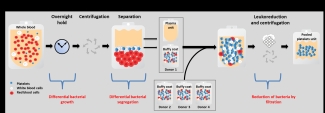How do bacteria behave during platelet production?
In brief...
This study shows how bacterial growth is affected by the buffy coat platelet production process.
At Canadian Blood Services, platelets are collected from donors by apheresis (platelets are obtained directly from the circulating blood of a single donor, using an apheresis machine) or by the buffy coat method (whole blood is collected from four donors and processed to isolate the platelets, which are then combined into a single platelet unit for transfusion). Our researchers investigated how different strains of bacteria survive and grow throughout the buffy coat platelet production process. Understanding the mechanisms of bacterial growth and survival during this process would help identify steps that can be optimized to minimize the risk of platelet contamination, increasing the safety of platelet products for Canadians
What did the researchers do?
To mimic bacterial contamination of platelets, the researchers added bacteria to units of whole blood donated for research and measured bacteria levels throughout the platelet buffy coat process. Eight bacterial strains from different sources (two commercial strains, two detected during routine screening, two found in expired platelet bags, and two implicated in fatal transfusion events) were tested. The researchers examined how bacteria levels changed during the overnight-hold step. They also examined how bacteria are divided when the whole blood is separated into the different fractions (buffy coat, red blood cells and plasma). Another goal of this study was to monitor changes in platelet quality markers (platelet activation marker CD62P and platelet response to dynamic light scattering on days 1 and 5 of storage) to determine whether they accurately predict bacterial contamination of the platelet product.
What did the researchers find?
- Bacterial growth during the overnight-hold step varied among the bacteria types. Both commercial strains examined were eliminated and the strains isolated from expired platelet bags stayed alive but did not multiply. The strains detected during routine screening and those involved in transfusion reactions multiplied to high concentrations.
- Bacteria segregated differently between the blood fractions, with more bacteria ending up in the red blood cells and buffy coat fraction than in plasma. Thus, when the buffy coat fractions are mixed with plasma, the bacteria are diluted, reducing the bacterial levels in the final platelet unit.
- Bacterial levels were also reduced by the leukoreduction step.
- The quality markers did not consistently indicate bacterial contamination of the platelets.
How can you use this research?
The researchers showed that bacteria strains multiplied differently in whole blood during the overnight-hold step of the buffy coat process. This could affect the efficacy of the routine bacterial screening done for platelet units. Platelet units are currently screened for bacteria by transferring a small volume of the unit into a liquid culture bottle that is then incubated to detect bacterial presence. Platelet units contaminated with bacterial types that proliferate during the overnight-hold step would likely have sufficient levels of bacteria in the final product to be detected by routine screening methods. On the other hand, high levels of bacteria could pose a challenge for pathogen inactivation technologies. The bacterial types that do not multiply during the overnight-hold step are reduced significantly in the final platelet unit due to the dilution and leukoreduction steps. This imposes a risk of not detecting bacterial contamination during the platelet screening process (false negative test result).
The platelet quality markers examined did not accurately predict bacterial contamination, indicating that these markers should not be used to supplement the existing bacterial screening methods.
The decrease in bacteria levels caused by the separation and filtration steps could help explain why bacterial contamination is observed less frequently in platelet units produced by the buffy coat method than in units collected by apheresis. This research could guide changes in platelet production or screening processes to improve the safety of platelet products. For example, screening of whole blood could be considered.

About the research team
This research was conducted in the laboratory of Dr. Sandra Ramirez-Arcos, a development scientist with the product and process development group at the Canadian Blood Services Centre for Innovation. Dr. Mariam Taha is a former PhD student in Dr. Ramirez-Arcos’ laboratory. Dr. Qi-Long Yi is a senior biostatistician at Canadian Blood Services. Craig Jenkins is a senior manager- product and process development at Canadian Blood Services’ Centre for Innovation and Dr. Peter Schubert is a research associate also at the Centre for Innovation and a clinical associate professor in the department of pathology and laboratory medicine at the University of British Columbia. The research was done in collaboration with Dr. Miloslav Kalab, an honorary research scientist at Agriculture and Agri-Food Canada.
This research unit is derived from the following publication(s)
[1] Taha M, Kalab M, Yi QL, Maurer E, Jenkins C, Schubert P, Ramirez-Arcos S. Bacterial Survival and Distribution During Buffy Coat Platelet Production. Vox Sang 2016. 111(4):333-340.
Acknowledgements: This research received funding support from Canadian Blood Services (Product and Process Development Program and Graduate Fellowship awarded to Dr. Mariam Taha), funded by the federal government (Health Canada) and the provincial and territorial ministries of health. The views herein do not necessarily reflect the views of the federal, provincial, or territorial governments of Canada. This research received support from LightIntegra Technology Inc. Canadian Blood Services is grateful to the blood donors who made this research possible. This ResearchUnit was prepared by Dr. Mariam Taha in collaboration with the knowledge mobilization group.
Keywords: Bacterial contamination, platelets, buffy coat, platelet production
Want to know more? Contact Dr. Ramirez-Arcos at sandra.ramirez@blood.ca